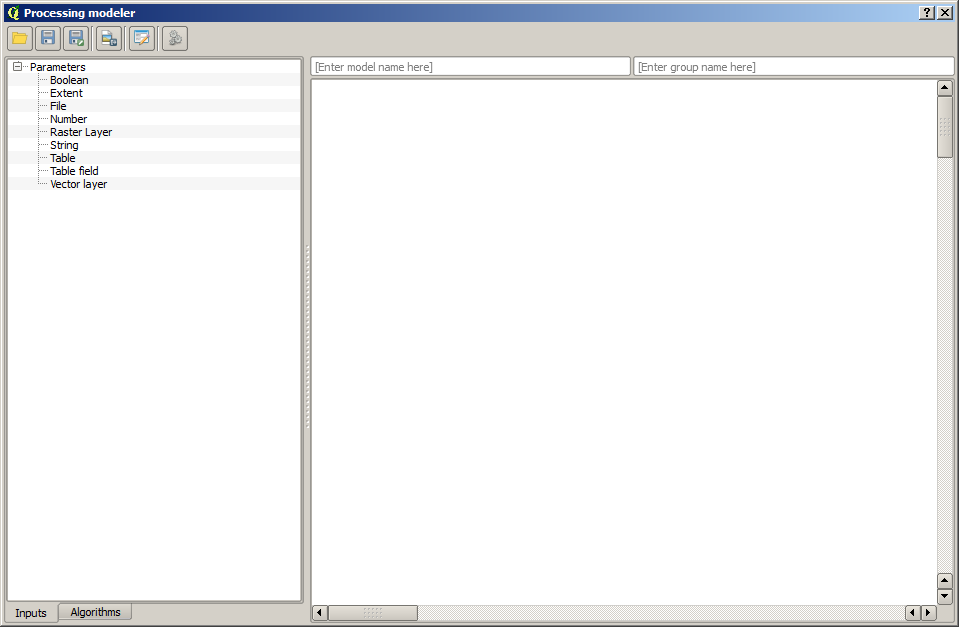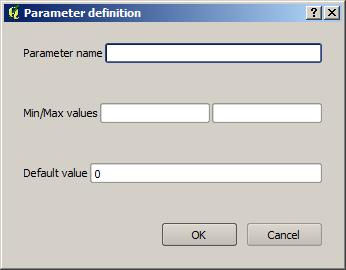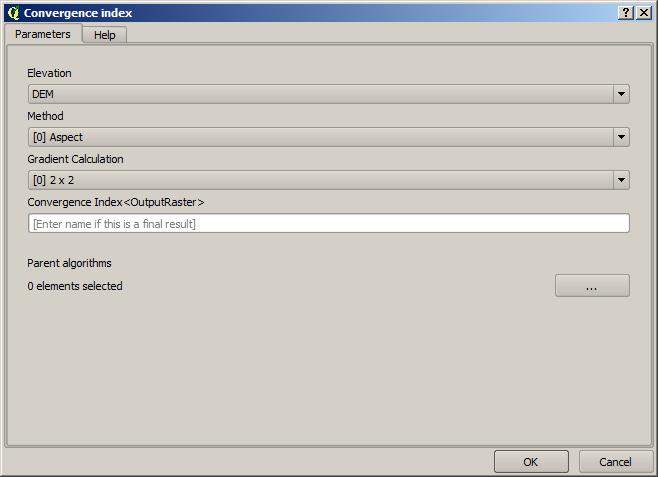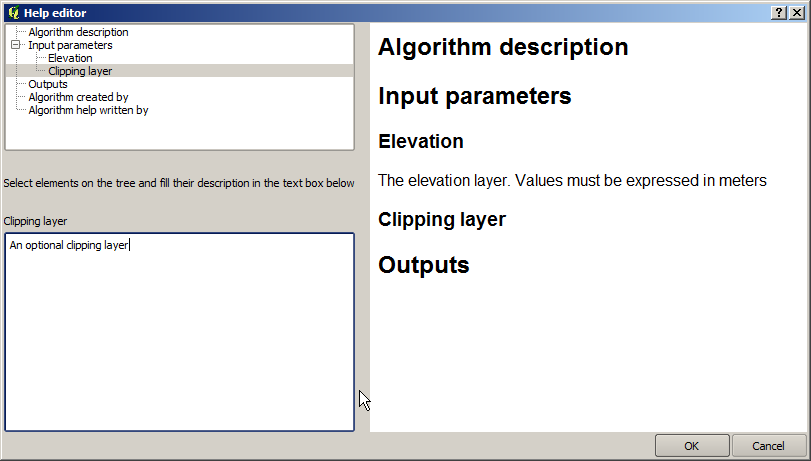.
Редактор моделей¶
The graphical modeler allows you to create complex models using a simple and easy-to-use interface. When working with a GIS, most analysis operations are not isolated, but rather part of a chain of operations instead. Using the graphical modeler, that chain of processes can be wrapped into a single process, so it is as easy and convenient to execute as a single process later on a different set of inputs. No matter how many steps and different algorithms it involves, a model is executed as a single algorithm, thus saving time and effort, especially for larger models.
Редактор моделей можно вызвать из меню Анализ ‣ Редактор моделей
Окно построителя моделей состоит из двух частей: слева находится панель вкладок, в ней выбирают составные элементы модели (исходные данные и алгоритмы), справа — рабочая область, где и создаётся модель.
Figure Processing 16:
Создание модели условно можно разделить на два этапа:
- Definition of necessary inputs. These inputs will be added to the parameters window, so the user can set their values when executing the model. The model itself is an algorithm, so the parameters window is generated automatically as it happens with all the algorithms available in the processing framework.
- Definition of the workflow. Using the input data of the model, the workflow is defined by adding algorithms and selecting how they use those inputs or the outputs generated by other algorithms already in the model.
Определение исходных данных¶
Перед созданием модели нужно задать необходимые исходные данные. Все доступные исходные данные собраны в левой части окна построителя моделей, на вкладке Исходные данные:
растровый слой (raster layer)
векторный слой (vector layer)
строка (string)
поле таблицы (table field)
таблица (table)
охват (extent)
число (number)
логическая величина (boolean)
файл (file)
Double-clicking on any of these elements, a dialog is shown to define its characteristics. Depending on the parameter itself, the dialog may contain just one basic element (the description, which is what the user will see when executing the model) or more of them. For instance, when adding a numerical value, as can be seen in the next figure, apart from the description of the parameter, you have to set a default value and a range of valid values.
Figure Processing 17:
После заполнения полей, в рабочую область построения модели добавится новый блок, соответствующий новому элементу.
Figure Processing 18:
Описание процесса¶
После того, как заданы все исходные данные, можно приступать к описанию процесса анализа. Доступные алгоритмы находятся на вкладке Algorithms в левой части окна. Алгоритмы сгруппированы точно так же как и в панели инструментов.
Figure Processing 19:
The appearance of the toolbox has two modes here as well: simplified and advanced. However, there is no element to switch between views in the modeler, so you have to do it in the toolbox. The mode that is selected in the toolbox is the one that will be used for the list of algorithms in the modeler.
To add an algorithm to a model, double-click on its name. An execution dialog will appear, with a content similar to the one found in the execution panel that is shown when executing the algorithm from the toolbox. The one shown next corresponds to the SAGA ‘Convergence index’ algorithm, the same example we saw in the section dedicated to the toolbox.
Figure Processing 20:
As you can see, some differences exist. Instead of the file output box that was used to set the file path for output layers and tables, a simple text box is used here. If the layer generated by the algorithm is just a temporary result that will be used as the input of another algorithm and should not be kept as a final result, just do not edit that text box. Typing anything in it means that the result is final and the text that you supply will be the description for the output, which will be the output the user will see when executing the model.
Selecting the value of each parameter is also a bit different, since there are important differences between the context of the modeler and that of the toolbox. Let’s see how to introduce the values for each type of parameter.
- Layers (raster and vector) and tables. These are selected from a list, but in this case, the possible values are not the layers or tables currently loaded in QGIS, but the list of model inputs of the corresponding type, or other layers or tables generated by algorithms already added to the model.
- Numerical values. Literal values can be introduced directly in the text box. But this text box is also a list that can be used to select any of the numerical value inputs of the model. In this case, the parameter will take the value introduced by the user when executing the model.
- String. As in the case of numerical values, literal strings can be typed, or an input string can be selected.
- Table field. The fields of the parent table or layer cannot be known at design time, since they depend on the selection of the user each time the model is executed. To set the value for this parameter, type the name of a field directly in the text box, or use the list to select a table field input already added to the model. The validity of the selected field will be checked at run time.
In all cases, you will find an additional parameter named Parent algorithms that is not available when calling the algorithm from the toolbox. This parameter allows you to define the order in which algorithms are executed by explicitly defining one algorithm as a parent of the current one, which will force the parent algorithm to be executed before the current one.
When you use the output of a previous algorithm as the input of your algorithm, that implicitly sets the previous algorithm as parent of the current one (and places the corresponding arrow in the modeler canvas). However, in some cases an algorithm might depend on another one even if it does not use any output object from it (for instance, an algorithm that executes an SQL sentence on a PostGIS database and another one that imports a layer into that same database). In that case, just select the previous algorithm in the Parent algorithms parameter and the two steps will be executed in the correct order.
Once all the parameters have been assigned valid values, click on [OK] and the algorithm will be added to the canvas. It will be linked to all the other elements in the canvas, whether algorithms or inputs, that provide objects that are used as inputs for that algorithm.
Elements can be dragged to a different position within the canvas, to change the way the module structure is displayed and make it more clear and intuitive. Links between elements are updated automatically.
You can run your algorithm anytime by clicking on the [Run] button. However, in order to use the algorithm from the toolbox, it has to be saved and the modeler dialog closed, to allow the toolbox to refresh its contents.
Сохранение и загрузка модели¶
Use the [Save] button to save the current model and the [Open] button to open any model previously saved. Models are saved with the .model extension. If the model has been previously saved from the modeler window, you will not be prompted for a filename. Since there is already a file associated with that model, the same file will be used for any subsequent saves.
Прежде чем сохранять модель, ей надо дать имя и указать в какой группе она будет находиться. Эти данные вносятся в два поля над рабочей областью построителя моделей.
Models saved on the models folder (the default folder when you are prompted for a filename to save the model) will appear in the toolbox in the corresponding branch. When the toolbox is invoked, it searches the models folder for files with the .model extension and loads the models they contain. Since a model is itself an algorithm, it can be added to the toolbox just like any other algorithm.
Расположение каталога моделей, при желании путь можно изменить в настройках в группе Modeler.
Модели, загруженные из каталога models появляются не только в панели инструментов, но и в списке алгоритмов вкладки Алгоритмы редактора моделей. Это значит, что модель может использоваться внутри более крупной модели, как любой другой алгоритм.
In some cases, a model might not be loaded because not all the algorithms included in its workflow are available. If you have used a given algorithm as part of your model, it should be available (that is, it should appear in the toolbox) in order to load that model. Deactivating an algorithm provider in the processing configuration window renders all the algorithms in that provider unusable by the modeler, which might cause problems when loading models. Keep that in mind when you have trouble loading or executing models.
Редактирование модели¶
Текущую модель можно редактировать, изменяя описание процесса и меняя связи между алгоритмами и исходными данными, описающими модель.
Нажатие правой клавиши мыши на блоке алгоритма вызовет следующее контекстное меню:
Figure Processing 22:
Выбор пункта Remove приведет к удалению выделенного блока алгоритма. Необходимо помнить, что алгоритм может быть удален тогда и только тогда, когда нет других, зависящих от него, алгоритмов. Т.е. результаты удаляемого алгоритма нигде не используются. Если вы попытаетесь удалить алгоритм, от которого зависят другие алгоритмы, появится предупреждение:
Figure Processing 23:
Пункт Edit или просто двойной щелчок по блоку алгоритма откроют диалог настройки параметров, где можно изменить исходные данные и значения параметров. В этом случае в качестве доступных исходных данных будут отображены не все имеющиеся в модели данные. Слои и значения, созданные на более поздних этапах процесса будут недоступны, если они приводят к циклическим зависимостям.
Выберите новые значения и нажмите кнопку [OK]. Связи между элементами модели будут соответствующим образом обновлены.
Activating and deactivating algorithms¶
Algorithms can be deactivated in the modeler, so they will not be executed once the model is run. This can be used to test just a given part of the model, or when you do not need all the outputs it generates.
To deactivate an algorithm, right-click on its icon in the model canvas and select the Deactivate option. You will see that the algorithm is represented now with a red label under its name indicating that it is not active.
Figure Processing 24:
All algorithms depending (directly or indirectly) on that algorithm will also appear as inactive, since they cannot be executed now.
To activate an algorithm, just right-click on its icon and select the Activate option.
Документирование моделей¶
Созданные модели можно документировать. Для этого нажмите на кнопку [Edit model help], откроется диалог редактирования описания модели.
Figure Processing 25:
On the right-hand side, you will see a simple HTML page, created using the description of the input parameters and outputs of the algorithm, along with some additional items like a general description of the model or its author. The first time you open the help editor, all these descriptions are empty, but you can edit them using the elements on the left-hand side of the dialog. Select an element on the upper part and then write its description in the text box below.
Описание модели сохраняется в тот же каталог, что и сама модель, автоматически при сохранении модели.
Немного о доступных алгоритмах¶
You might notice that some algorithms that can be be executed from the toolbox do not appear in the list of available algorithms when you are designing a model. To be included in a model, an algorithm must have a correct semantic, so as to be properly linked to others in the workflow. If an algorithm does not have such a well-defined semantic (for instance, if the number of output layers cannot be known in advance), then it is not possible to use it within a model, and thus, it does not appear in the list of algorithms that you can find in the modeler dialog.
Additionally, you will see some algorithms in the modeler that are not found in the toolbox. These algorithms are meant to be used exclusively as part of a model, and they are of no interest in a different context. The ‘Calculator’ algorithm is an example of that. It is just a simple arithmetic calculator that you can use to modify numerical values (entered by the user or generated by some other algorithm). This tool is really useful within a model, but outside of that context, it doesn’t make too much sense.
Saving models as Python code¶
Given a model, it is possible to automatically create Python code that performs the same task as the model itself. This code is used to create a console script (we will explain scripts later in this manual) and you can modify that script to incorporate actions and methods not available in the graphical modeler, such as loops or conditional sentences.
This feature is also a very practical way of learning how to use processing algorithms from the console and how to create new algorithms using Python code, so you can use it as a learning tool when you start creating your own scripts.
Save your model in the models folder and go to the toolbox, where it should appear now, ready to be run. Right-click on the model name and select Save as Python script in the context menu that will pop up. A dialog will prompt you to introduce the file where you want to save the script.









